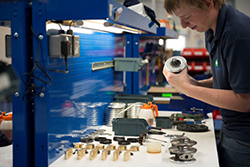
Today’s automotive repair industry is faced with an overwhelming range of repair parts. Amid claims of exceptional quality at extraordinarily cheap prices, here Martyn Howorth, Sales Director, Melett Ltd., explores the reasons why some turbocharger components are offered at such low prices, and what the real cost of these low quality parts means to the repair industry.
Global price for raw materials
As global demand for turbochargers increases, the raw materials used in the manufacture of the components are becoming more expensive. Raw material prices have conventionally been determined by the Global Price Index (GPI), with stockists adding their margin before selling to the mass market.
Using a turbocharger turbine wheel as an example, a major part of the cost of the turbine wheel is based upon the current market cost of Nickel — the main component of the Inconel material, plus the manufacturers mark-up. The price of an Inconel wheel will be agreed on a monthly basis, if the GPI increases by 3% for example, stockists reserve the right to charge more for the raw materials, therefore increasing the global cost for manufacturers. Nickel is a popular element used during the manufacture of many automotive components, and in particular turbine wheels, as it is able to withstand the tough operating conditions and extreme temperatures of a modern turbocharger.
Cutting costs, cutting quality
In countries where the market is saturated with many new parts suppliers, under cutting margins is now common practice resulting in companies selling low quality products at rock bottom prices. In China, for example, there is a limited supply of nickel, and therefore stockists in that marketplace can sell it at a premium, as a result this should be reflected in the market price of a turbine wheel. However, the way many manufacturers are producing turbine wheels at a lower cost is to simply use a lower grade of Inconel with less nickel.
This will significantly reduce the wheels overall performance and durability, leading to unreliable repairs and premature failure. Historically, low cost manufacturers were only concerned with undercutting each other’s margins, however in today’s environment they are now forced to reduce the quality of the cast materials in order to compete with each other. As a result we are seeing a reduction in quality.
High quality repair parts will always hold a premium in comparison to the lower quality alternatives. It is important to understand the point at which cutting margins turns into reducing quality. Every component has a minimal price point and anything lower than that point can only be achieved by using lower grade raw materials in the manufacturing process.
The impact on the market
The repair industry as a whole is currently experiencing an influx of new low cost, low quality parts suppliers into the market. In many cases the components look very similar to their higher quality counterparts, however, component failure within days of operation is common as these poor quality products cannot perform efficiently under the extreme operating conditions.
Premature turbocharger failure is a common problem associated with the use of lower quality repair parts, which in turn can lead to an increase in warranty returns and loss of customer confidence in repairs. It is important that the automotive repair market as a whole considers the real cost of using low quality repair parts, not only to their own business reputations but to the reputation of the entire industry.


